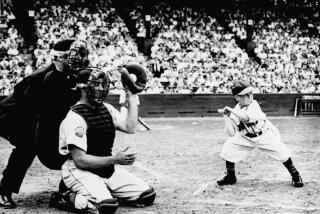Stuff of legends
- Share via
He was a little guy, which was shocking at first, with short arms, thick glasses and an easy smile. They called him “Dalko” and guys liked to hang with him and women wanted to take care of him and if he walked in a room in those days he was probably drunk.
He had a record 14 feet long inside the Bakersfield police station, all barroom brawls, nothing serious, the cops said. He rode the trucks out at dawn to pick grapes with the migrant farm workers of Kern County -- and finally couldn’t even hold that job.
This was the legend; this was Steve Dalkowski, the hardest thrower who ever lived.
Many years ago, playing professional baseball in the bush leagues for the Baltimore Orioles, in the wake of the great players who preceded me -- Brooks Robinson, Boog Powell, Jim Palmer and the rest -- the stories passed on by bus drivers and groundskeepers and minor league players and managers were not about the exploits of those Hall of Famers, they were about an obscure pitcher named Dalkowski.
Orioles manager Earl Weaver saw Nolan Ryan and Sandy Koufax and “Sudden” Sam McDowell and Dick Radatz and said, “Dalko threw harder than all of ‘em.”
Ted Williams stepped in for one pitch during a spring training game and walked away. “Fastest I ever saw,” he said. Teddy Ballgame, who regularly faced Bob Feller and Herb Score and Ryne Duren, wanted no part of Dalko.
In Wilson, N.C., Dalkowski threw a pitch so high and hard that it broke through the narrow welded wire backstop, 50 feet behind home plate and 30 feet up. On a $5 bet he threw a baseball through a wooden fence. On a $10 bet he threw a baseball from the center-field fence toward home plate, over the 40-foot-high backstop screen.
He threw high and tight and ripped off a guy’s ear in Elmira, N.Y. Or was it Appleton, Wis.? Or Stockton? When the legend becomes fact, print the legend, it is said in a John Ford movie. But with Dalkowski the mythology and the inarguable facts of baseball statistics are inseparable.
Look at the numbers and weep. In his first two seasons of pro baseball in the Appalachian and South Atlantic Leagues, he averaged 19 strikeouts and 18 walks per nine innings. Playing for the Aberdeen Pheasants in a low Class-A league in South Dakota in 1959, he averaged 20 walks and 15 strikeouts for nine innings. In the Eastern League, he struck out 27, walked 16 and threw an astounding 283 pitches in a game.
Then there was the time at Elmira when he was pulled from the game after throwing 120 pitches -- it was still the second inning.
Though he terrified hitters, he rarely hit a batter. Cal Ripken Sr., his catcher through much of the minor leagues (and one of my managers), said, “Dalko was the easiest pitcher I ever caught. He was only wild high and low, rarely inside or out -- but the batters didn’t know that.”
Weaver thought Dalkowski was overcoached and when he finally made it to double-A Elmira after nine years in the remote outposts of the minors, he persuaded Dalko to “take a little off the fastball.”
Dalkowski still threw in the high 90s, maybe higher, and for one brief stretch pitched better than any kid ever dreamed. In a 52-inning span, he struck out 104 batters with only 10 walks and a single earned run.
He finished the 1962 season with the triple-A Rochester Red Wings and the following spring made the Orioles’ roster, his nearly decade-long journey in the wilderness finally over, it seemed. That’s where the retired Williams stepped in -- and out -- of the box against him. That’s where scouts and reporters gathered to buzz about the phenomenon, only to see this explosive arm die in a whimper, fielding a bunt by Yankees pitcher Jim Bouton of all people -- the same Bouton who would later write the classic “Ball Four.”
Dalko picked up the bunt, flipped the toss to first . . . and his arm went dead.
From his earliest days as a baseball and football star in New Britain, Conn., Dalkowski’s real problem wasn’t controlling a baseball, but controlling the bottle.
Playing baseball in Stockton and Bakersfield several years behind Dalko, but increasingly aware of the legend, I would see a figure standing in the dark down the right-field line at old Sam Lynn Park in Oildale, a paper bag in hand. Sometimes he’d come to the clubhouse to beg for money.
Our manager, Joe Altobelli, would talk to him, give him some change, then come back and report, “That was Steve Dalkowski.” And a clubhouse full of cocky, young, testosterone-driven baseball players sat in awe -- of the unimaginable gift, the legend, the fall.
Altobelli, a career minor leaguer with some big league experience, was finishing out a career in Rochester when Dalko finally made it to triple A. He was assigned to be Dalko’s roommate with the mandate to “help mature the kid.”
Joe said he loved Dalko but he never saw him except at the park -- he was out drinking all night all the time. But come game time, somehow, Dalko showed up and threw his 100-mph heaters.
This relationship -- the veteran who loved a game more than the game loved him, and the God-gifted rookie who was otherwise a lost soul -- was the inspiration for “Bull Durham,” though nothing specific in Altobelli or Dalkowski’s character is applicable.
Dalko pitched before radar guns, so nobody is really sure how fast he threw. But the Orioles took him to the Aberdeen Proving Ground, a military test site near Baltimore, and lined him up 60 feet 6 inches from a tube that judged wind speed. Without a mound, in sneakers, Dalko fired away for nearly an hour, his pitches registering in the mid-90s.
Some guess his fastball from a mound approached 110 mph. We’ll never know.
When Dalkowski’s career ended, after he’d bounced around trying for a comeback with his aching shoulder -- he threw more than 90 mph with a bad arm -- he submitted completely to whatever solace the bottle held and began a lost journey that led him to the migrant farmworker fields of Bakersfield.
Wandering the streets of L.A. years later on Christmas Eve, he was rescued and reunited with his wife from Bakersfield who thought he’d been dead for years. She died shortly thereafter and finally his family from Connecticut discovered he was still breathing, barely, and brought him home.
Racked with alcoholic dementia, Dalko has been in a New Britain home for 15 years. He attends minor league games, a celebrity now. He gets out of the home for family picnics. He is, if you can use the term, at peace, according to his family.
Dalkowski will be inducted today into the Baseball Reliquary’s Shrine of the Eternals -- its Hall of Fame -- along with Roger Maris and Jim Eisenreich, during an afternoon ceremony at the Pasadena Central Library.
But what lingers is not the drinking or the abuse or the desperation. We’ve seen that and know these same demons touch us at times.
It’s the gift from the gods -- the arm, the power -- that this little guy could throw it through a wall, literally, or back Ted Williams out of there. That is what haunts us.
He had it all and didn’t know it. That’s why Steve Dalkowski stays in our minds. In his sport, he had the equivalent of Michelangelo’s gift but could never finish a painting.
--
(BEGIN TEXT OF INFOBOX)
Minor sensation
Career statistics for Steve Dalkowski (* -- led league):
(Table not retained).
Source: baseball-reference.com
More to Read
Go beyond the scoreboard
Get the latest on L.A.'s teams in the daily Sports Report newsletter.
You may occasionally receive promotional content from the Los Angeles Times.










